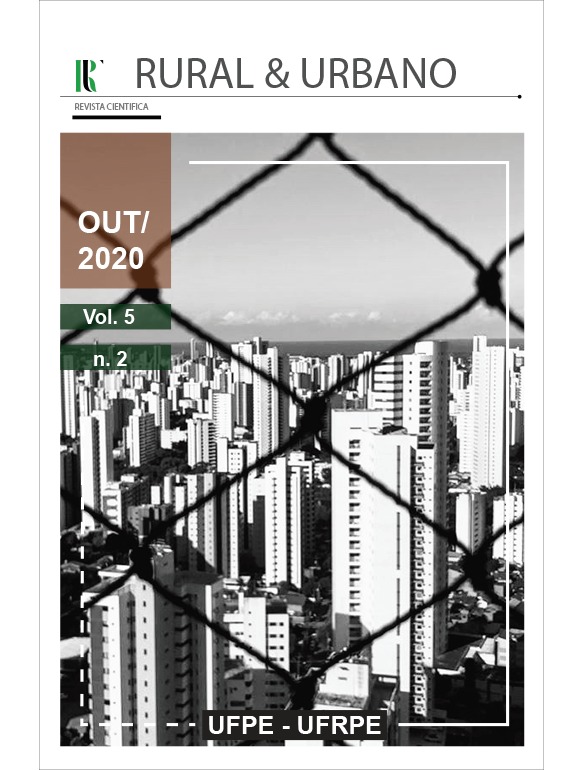The different sides of COVID-19 and social isolation: Changes and impacts in the dynamics of coexistence of/at home
DOI:
https://doi.org/10.51359/2525-6092.2020.248078Keywords:
social isolation; living space; pandemicAbstract
This article seeks to outline a geographic-psychological profile of the ways of relating with and without pressure from the environment on the individual and reveals to us how relationships are being built and/or destroyed in these pandemic times. We tried to understand the different sides of COVID-19 as a vector of distancing and changing the dynamics of social, labor and leisure relationships that had to be completely restructured during the pandemic period. Therefore, we prepared a questionnaire with 15 questions that were answered by 53 people. The applicability was given remotely, interspersing subjective and objective questions. New coronavirus pandemic has shown the vulnerability of human beings, whether for physical or mental reasons, contributing to the construction of new models of social relations in the midst of chaos.
References
AFONSOP. The Impact of the COVID-19Pandemic on Mental Health. Acta Med Port.. Vol. 33:2020. p. 356-357.
ARRUDA, L.V.; BELIZÁRIO, M.A.S.; CAVALCANTE, M.B.; BORBA, G.K.O. Elos e flagelos na relação sociedade-natureza:Em busca da conscientização ambiental para preservar a vida.Revbea, v.15, nº 4, São Paulo, 2020. p. 279-300.
ASMUNDSON, G.J.G., & TAYLOR, S. Coronaphobia: fear and the 2019-nCoV outbreak. Journal of Anxiety Disorders, 70,2020. p. 1-2.
BONNEMAISON, J. Viagem em torno do território. In: CORRÊA,R.L; ROSENDAHL, Z.(Orgs.). Geografia cultural: um século. Volume 3. Rio de Janeiro: EdUERJ, 2002.p. 83-132.
BROOKS, S.K.; WEBSTER, R.K.; SMITH, L.E.; WOODLAND, L.; WESSELY, S.; GREENBERG, N.; & RUBIN, G.J. The psychological impact of quarantine and how to reduce it: rapid review of the evidence. The Lancet, 395(10227), 2020. p. 912-920.
CARVALHO, P.M.M.; MOREIRA, M.M.; OLIVEIRA, M.N.A.; LANDIM, J.M.M.; & ROLIM NETO, M.L. The psychiatric impact of the novel coronavirus outbreak. Psychiatry Research, 286(112902), 1-2.(2020).
COUTINHO, M.P.L.; DO BÚ, E. A técnica de associação livre de palavras sobre o prisma do software tri-deux-mots (version 5.2). Revista Campo do Saber, vol.3 no.1 –jan/jun de 2017.p. 2019-243.
CREPALDI, M. A. et al . Terminalidade, morte e luto na pandemia de COVID-19: demandas psicológicas emergentes e implicações práticas.Estud. psicol. (Campinas),Campinas ,v. 37,2020 . n.p.
FÓRUM BRASILEIRO DE SEGURANÇA PÚBLICA. Violência doméstica durante a pandemia de COVID-19.16/04/2020. (https://forumseguranca.org.br/wp-content/uploads/2018/05/violencia-domestica-covid-19-v3.pdf) Acessado em 14/08/2020.
GOYAL, K.; CHAUHAN, P.; CHHIKARA, K.; GUPTA, P.; & SINGH, M.P. Fear of COVID 2019: first suicidal case in India. Asian Journal of Psychiatry, 49(101989). http://dx.doi.org/10.1016/j.ajp.2020.101989
GRISOTTI, M. Pandemia de COVID-19: agenda de pesquisas em contextos de incertezas e contribuições das ciências sociais.Physis,Rio de Janeiro,v. 30,n. 2,2020. p. 1-7.
JUNG, S.J., &JUN, J.Y. Mental health and psychological intervention amid COVID-19Outbreak: perspectives from South Korea. Yonsei Medical Journal, 61(4), 2020. p.271-272.
LIUX,;Kakade M,;Fuller C.J,;FANB,;Fang Y,;Kong J,;Guan Z,;Wu P. Depression after exposure to stressful events: lessons learned from the severe acuterespi-ratory syndrome epidemic. Compr Psychiatry. 53:2012. p. 15-23.
ORNELL, F.; SCHUCH, J.B.; SORDI, A.O.; KESSLER, F.H.P.;Pandemic fear’’ and COVID-19: mental health burden and strategies. BRAZ.J. Psychiatry.vol.42 nº.3 São Paulo maio / junho de2020. p. 232-235.
REYNOLDS, D.L.; GARAY, J.R.; DEAMOND, S.L.; MORAN, M.K.; GOLD, W.;STYRA R. Understanding, compliance and psy-chological impact of the SARS quarantine experience. Epidemiol Infect. 136:2008. p. 997-1007.
SARAMAGO, J. Ensaio sobre a cegueira. 1. ed. São Paulo: Companhia das Letras, 2019. 314p.
SANTOS,B.S. A cruel pedagogiado vírus. –1ª ed. –São Paulo: Boitempo.[recurso eletrônico], 2020. 50p.
SHOJAEI, S.F.;& MASOUMI, R. The importance of mental health training for psychologists in COVID-19outbreak. Middle East Journal of Rehabilitation and Health Studies, 7(2), (2020).p. 1-3.
SILVA, L. J da .A Globalização da doença.Rev. Saúde Pública, São Paulo, v. 37, n.3, , junho de 2003 pág.273-274.
TUAN, Y-F. Paisagens do medo. (Trad.) Lívia deOliveira. São Paulo: Editora UNESP, 2005. 376p.
TUAN, Y-F. Topofilia. Um estudoda percepção, atitudes e valores do meio ambiente. (Trad) Lívia deOliveira. Londrina: Eduel, 2012. 342p.
VAZ, A.C.; ANDRÉ, B.P. O sentimento de pertença de alunos do bairro da Rasa em Armação de Búzios/RJ. Revista Científica Internacional, Nº 4, v. 11, 2016. p. 170-184.
WU, P.; LIU, X.; FANG, Y.; FAN, B.; FULLER, C.J.;GUAN, Z., et al. Alcohol abuse/dependence symptoms among hospital employees exposed to a SARS outbreak. Alcoholand Alcholism.43:2008. p. 706-712.
Downloads
Published
How to Cite
Issue
Section
License
Copyright (c) 2020 Maria Aletheia Stedile Belizário, Luciene Vieira Arruda, Luiza Loredanna Maraes Stedile, Bruno Stedile Belizário

This work is licensed under a Creative Commons Attribution-NonCommercial-ShareAlike 4.0 International License.
Autores que publicam nesta revista concordam com os seguintes termos:
a) Autores mantém os direitos autorais e concedem à revista o direito de primeira publicação, com o trabalho simultaneamente licenciado sob a Creative Commons Atribuição-Não Comercial-Compartilha Igual 4.0 Internacional  , que permite o compartilhamento do trabalho com reconhecimento da autoria e publicação inicial nesta revista.
, que permite o compartilhamento do trabalho com reconhecimento da autoria e publicação inicial nesta revista.
b) Autores têm autorização para assumir contratos adicionais separadamente, para distribuição não-exclusiva da versão do trabalho publicada nesta revista (ex.: publicar em repositório institucional ou como capítulo de livro), com reconhecimento de autoria e publicação inicial nesta revista.
c) Autores têm permissão e são estimulados a publicar e distribuir seu trabalho online (ex.: em repositórios institucionais ou na sua página pessoal) a qualquer ponto antes ou durante o processo editorial, já que isso pode gerar alterações produtivas, bem como aumentar o impacto e a citação do trabalho publicado.

